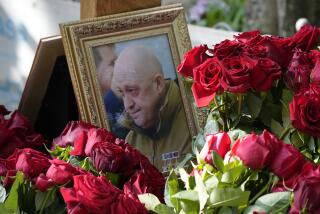Collateral Damage
- Share via
Efforts to combat international narcotics trafficking have taken many lives, none more innocent than those of American missionary Veronica Bowers and her infant daughter, Charity.
The two were killed when the single-engine Cessna 185 they were aboard was fired on last Friday by a Peruvian air force jet over an area near Peru’s border with Colombia and Brazil. The small plane was wrongly suspected of involvement in drug smuggling. Over the weekend Peruvian Foreign Minister Javier Perez de Cuellar said his country was fully responsible for the tragedy, a view echoed by U.S. authorities but disputed Monday by Peru’s air force.
Because a U.S. plane involved in drug-smuggling surveillance was a factor in the incident, it’s vital that the documented record of what took place be released. That includes cockpit recordings and a videotape of the encounter.
The surveillance plane was manned by a crew under contract to the CIA and also carried a Peruvian air force liaison officer. Along with the Defense Department, the Customs Service, the Drug Enforcement Administration and other agencies, the CIA regularly flies drug-tracking missions. It was the CIA plane that first spotted the Cessna, which is owned by the Assn. of Baptists for World Evangelism.
After it reported the contact, a Peruvian officer on the ground said he could not find a flight plan for the plane. A Peruvian A-37 jet was then sent aloft.
U.S. officials say what followed violated the rules of engagement governing such encounters. The Peruvian jet apparently failed to use international visual procedures to tell the Cessna to land for inspection. Under orders from the Peruvian officer aboard the U.S. plane, and over the repeated objections of the American crew, the Peruvian jet fired on the Cessna, killing Veronica and Charity Bowers and seriously wounding the plane’s pilot.
The Cessna, meanwhile, was in contact with the ground over a civilian radio channel. Peruvian air force personnel at the same time were trying unsuccessfully to reach it on military channels.
The breakdown in communications does not explain or excuse the apparent haste with which the Peruvians acted. Even as a spokesman for the Peruvian air force insisted Monday that its personnel had “followed the procedures,” the White House announced the suspension of the joint drug interdiction program because “there are questions about the way the mission was carried out.”
The administration also said the flights should be resumed as soon as possible. However, there is much to be resolved first, including the confusion over whether and when a flight plan for the Cessna was filed. The role of the CIA crew, as reported by U.S. officials, can and should be more fully explained by full release of cockpit voice recordings and the videotape of the encounter reportedly taken from the surveillance plane. Drug interdiction operations are important. Even more so is making sure innocent lives aren’t sacrificed in the effort.
More to Read
Sign up for Essential California
The most important California stories and recommendations in your inbox every morning.
You may occasionally receive promotional content from the Los Angeles Times.













